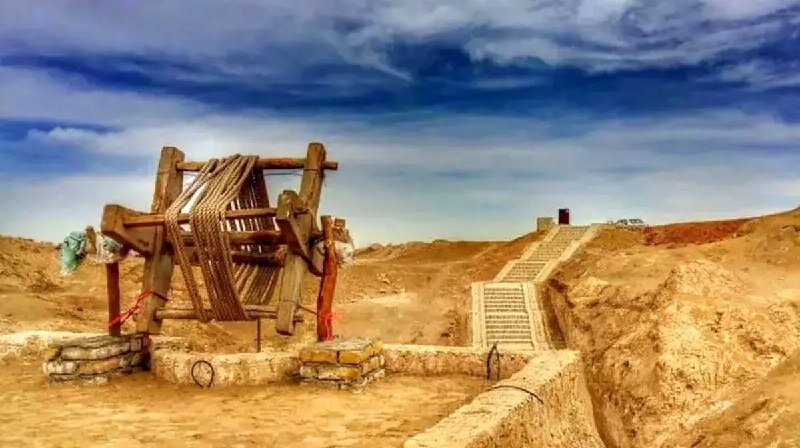Water history in Iran: Qanats behind expansion of the Achaemenid Empire

TEHRAN—An expert on qanat (an ancient underground water network) who has conducted extensive studies on the remaining qanats of Iran believes that the great emperors of Iran during Achaemenid and Sassanid eras were indebted to the Iranians' aqueducts and hydrological knowledge, ILNA wrote.
Mohammad Barshan says: “If someone irrigated a dry land through construction of qanat during Achaemenid era, he/she was exempt from paying tax for five years.”
The role of water in life and the way of suing it was very important for Iranians in the past.
The formation of qanats with a precise and engineered model is based on the attitudes of Iranians to the role of water in their livelihoods.
Iran has the longest and oldest qanats of the world.
UNESCO registered 11 Iranian qanats in world heritage list as engineering masterpieces in management of water resources.
UNESCO has it that “The qanats provide exceptional testimony to cultural traditions and civilizations in desert areas with an arid climate.”
Generally, each qanat comprises an almost horizontal tunnel for collecting water from an underground water source, usually an alluvial fan, into which a mother well is sunk to the appropriate level of the aquifer.
Barshan, who is manager of Kerman Qanat Center, said stone inscriptions and tablets remaining from ancient Iran show that the people of that time brought groundwater to their villages and cities by digging long and very deep aqueducts.
Professor Henry Gubler, who has researched the aqueducts of Iran for more than 30 years, estimates the length of these aqueducts to be more than 400,000 kilometers, which is several times longer than the Great Wall of China.
Barshan said Gonabad Qanat is 35 kilometers long and more than 300 meters deep, with wells at regular intervals of 50 meters. It is one of the masterpieces left from Achaemenid era.
Nasser Khosrow Qobadiani in his trip to Gonabad calls Gonabad Qanat as a water-rich and profitable aqueduct.
Barshan continued that the splendor of Iran's aqueducts is such that international groundwater experts such as Batello, Avelman, and others believe that the aqueducts of Los Angeles and Pasadena, California, as well as the aqueducts of Chile and Mexico, were built by Iranian engineers and workers.
Although the majority of ancient civilizations have been formed on the banks of rivers such as the Nile, Tigris, Euphrates, Huanghu and Yangtze, but the only country that formed far from any major river and became a global empire was Iran.
He pointed to progress of hydrological knowledge in Iran during Islamic era.
In the book Athar al-Baqiyyah by Abu Rayhan al-Biruni, there is much emphasis on the increase and decrease of the water of springs and rivers. The increase of water is not the same throughout the year, but they have great differences.
For example, the water of the Jihun increases when the Tigris and Euphrates decrease, and the reason for this is that any river whose source is in cold regions has a lot of water in summer and less in winter because most of its main water is collected from springs, and the humidity in the mountains causes the increase and decrease of the water of these rivers.
He mentioned that Avicenna, the great Persian physician and the most famous and influential philosopher and scientist of the medieval Islamic world, has allocated a chapter of his book “Alaee Encyclopedia” to water knowledge.
Kurit dam which has been constructed near Tabas during Achaemenid era was renovated once in Sassanid era and the other time during Khajeh Nasireddin Toosi era (1201–1274 CE).
This dam, which was 64 meters high, was the largest dam in the world for more than 600 years.
Over 60 dams were constructed during Achaemenid era in Iran. Also, a bridge was built in Shushtar with a length of more than 500 meters during the Sassanid era. Also, bridges can be seen throughout Iran, including Sarvestan and Mianeh, which are all signs of the knowledge of hydrology in ancient Iran.
Elsewhere in his remarks, he pointed out to Iranian watermills which were considered another part of hydrology cycle of Iranians. Iranians had mills including wheel mill and floating mill in ancient Iran.
The remains of these mills can still be seen in Shushtar. The water purification device in Chogha Zanbil is also the first and oldest water purification device in the world, which, through related vessels, transformed the muddy water of the Karkheh River into healthy and refreshing water. The water reservoirs of the desert provinces were another example of the advanced water industry in ancient Iran.
Centers dedicated to storing and purifying water simultaneously transformed and cooled it. Traces of water coolers in Susa and Shushtar are also found, along with descriptions from tourists and sailors such as Naser Khosrow.
Also, lighthouses and climatic conditions of seas are the other part of hydrology science of Iranians.
KD
